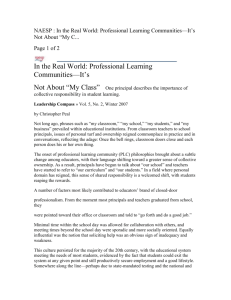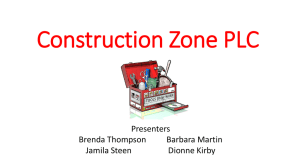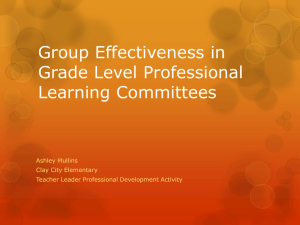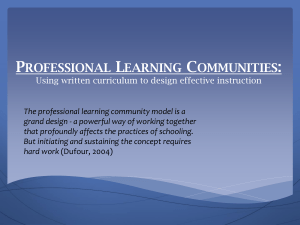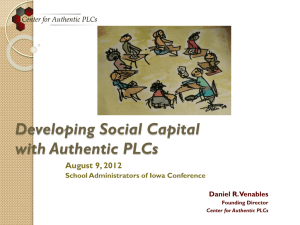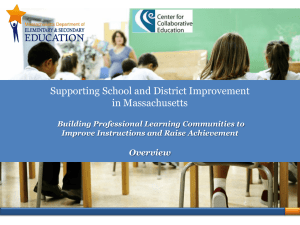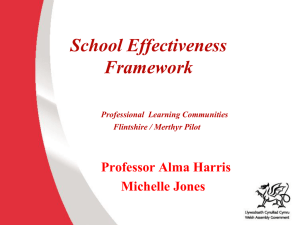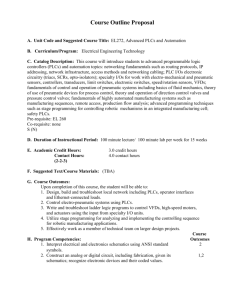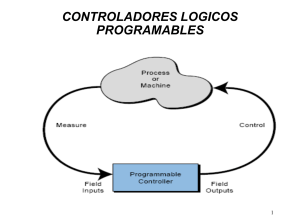Research – Professional Learning Communities
advertisement
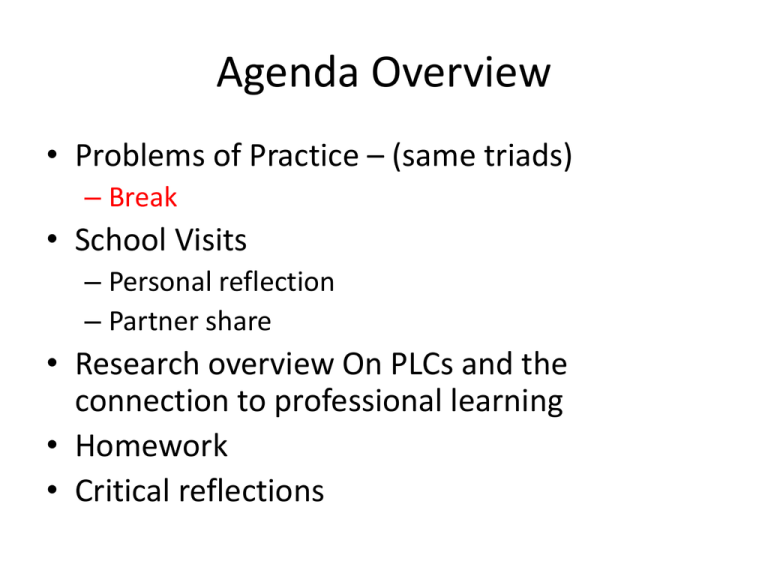
Agenda Overview • Problems of Practice – (same triads) – Break • School Visits – Personal reflection – Partner share • Research overview On PLCs and the connection to professional learning • Homework • Critical reflections Powerful Professional Learning Professional Learning Community Teachers Improve Their Practice in the Company of Their Peers • A PLC is a particular design for collaborative professional learning. • There is no universal definition of a professional learning community (Stoll, 2008). • Key features of PLC’s date back to Dewey. • A key purpose of PLCs is to enhance teacher effectiveness as professionals, for students’ ultimate benefit (Stoll, 2008). This is why our project’s definition suggests that the ultimate outcome of PLCs has to be experienced by students. • An effective professional learning community has the capacity to promote and sustain the learning of all professionals in the school community with the collective purpose of enhancing pupil learning (Bolam et al., 2005, p. 145) PLC’s: A Review of the Literature Stoll, L.; Bolam, R.; McMahon, A; Wallace, M.; Thomas, S. (2006) http://schoolcontributions.cmswiki.wikispaces.net/file/view/PROFESSIONAL+LEARNING+COMMUNITIES+A+REVIEW+OF.pdf • Characteristics: – Shared values and vision – Collective responsibility – Reflective professional inquiry – Collaboration – Group, as well as individual, learning is promoted – Mutual trust and respect – Inclusive membership Impact of PLCs • Impact cannot be separated from purpose. • Purpose is not to be a PLC, key purpose is to enhance teaching effectiveness as professionals, for students’ benefit. – Greater confidence – Enhanced efficacy towards improving student learning – Enthusiasm for collaborative work with colleagues and peers • Students achieved at higher levels in schools with positive professional communities. Timperley (2007) • Teacher Professional Learning and Development: Best Evidence Synthesis • http://www.oecd.org/edu/school/48727127.pdf • 97 individual research studies or groups of studies Timperley (Findings) • Opportunities for teachers to engage in professional learning and development can have a substantial impact on student learning. 1. The context of professional learning and development that impacted student outcomes: a. b. c. d. e. f. g. Extended time for opportunities to learn was necessary but not sufficient. How time was used was important. External expertise was typically necessary but not sufficient. Teachers’ engagement in learning at some point was more important than initial volunteering. Prevailing discourses challenged. The challenge to discourses typically involved iterative cycles of thinking about alternatives and becoming aware of learning gains made as a result of changed teaching approaches. Opportunities to participate in a professional community of practices were more important than place. Effective communities provided teachers with opportunities to process new understandings and challenge problematic beliefs, with a focus on analyzing the impact of teaching on student learning. Consistency with wider trends in policy and research. Active school leadership. Focused on developing a learning culture within the school and were learners along with the teachers and created the conditions for distributing leadership by developing the leadership of others. Timperley (Findings) 2. The Content of Professional Learning and Development: a. b. c. d. Different aspects integrated. Integration of theory and practice was a key feature. Theory provided the basis for making curricular and pedagogical decisions. Teachers were assisted to translate theory into classroom practice. Integration of pedagogical content knowledge, of assessment information, and of how students learn particular curricula was a feature of most curriculum-based interventions documented in the core studies but was given different emphasis in different curricula. Clear links between teaching and learning and/or student–teacher relationships established. Assessment used to focus teaching and enhance self-regulation. Sustainability. Sustainability was dependent on teachers acquiring both of the following: Indepth understanding of theory, which served as a tool to assist instructional decision making; The skills of inquiry to judge the impact of teaching on learning and to identify next teaching steps. Timperley (Findings) 3. Activities Constructed To Promote Professional Learning a. b. c. d. e. f. 4. Content and activities aligned. A variety of activities needed. Content conveyed through the activity was more important than any particular activity. Professional instruction sequenced. Understandings discussed and negotiated. Initial activities sometimes showed that there were problems with teachers’ existing theories of practice. Student perspective maintained. Learning Processes and Teachers’ Responses 3. 4. 5. 6. 7. Substantive change is difficult Necessary to develop new understandings. Cueing existing knowledge was necessary for theory engagement but insufficient to change practice. Some new understandings were consistent with current positioning. Some new understandings created dissonance with current positioning. In a few interventions, teachers learned to regulate their own and others’ learning. Timperley, 2007 Discuss • What might you, as the primary school leader, do to make the PLC in your school a more effective professional learning environment?

